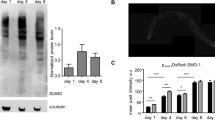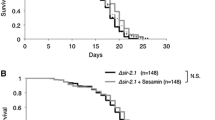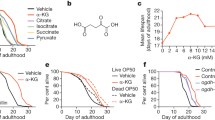Abstract
It is well understood that sir2 (sirtuin), an NAD-dependent deacetylase, is essential for the extension of lifespan under caloric restriction. However, the mechanism underlying activation of sir2 is unclear. Life extension through caloric restriction requires the sir2 ortholog sir-2.1 in nematodes but occurs independently of the forkhead-type transcription factor DAF-16. We aimed here to elucidate the correlation between life extension in nematodes and NAD-dependent activation of sirtuin by analyzing the relationship between NAD and DAF-16. Lifespan was extended when Caenorhabditis elegans were bred using medium containing NAD. An RNA interference experiment revealed that life extension by NAD was sir-2.1 dependent. However, life extension by NAD did not occur in daf-16-RNAi nematodes, suggesting that NAD-dependent longevity requires daf-16. This result suggested that different signaling pathways are involved in life extension resulting from caloric restriction and from NAD addition. Expression of sod-3, a target gene of daf-16, and increased oxidative-stress resistance and adiposity were observed in response to NAD addition, indicating that NAD activated daf-16 in each phenotype. These results suggest that NAD affected lifespan through the activation of SIR-2.1 and DAF-16 along a signaling pathway, namely insulin-like signalling pathway (at least parts of it), different from that associated with caloric restriction.






Similar content being viewed by others
References
Anderson RM, Bitterman KJ, Wood JG, Medvedik O, Cohen H, Lin SS, Manchester JK, Gordon JI, Sinclair DA (2002) Manipulation of a nuclear NAD+ salvage pathway delays aging without altering steady-state NAD+ levels. J Biol Chem 277:18881–18890. doi:10.1074/jbc.M111773200
Anderson RM, Bitterman KJ, Wood JG, Medvedik O, Sinclair DA (2003a) Nicotinamide and PNC1 govern life extension by calorie restriction in Saccharomyces cerevisiae. Nature 423:181–185. doi:10.1038/nature01578
Anderson RM, Latorre-Esteves M, Neves AR, Lavu S, Medvedik O, Taylor C, Howitz KT, Santos H, Sinclair DA (2003b) Yeast life-span extension by calorie restriction is independent of NAD fluctuation. Science 302:2124–2126. doi:10.1126/science.1088697
Araki T, Sasaki Y, Milbrandt J (2004) Increased nuclear NAD biosynthesis and SIRT1 activation prevent axonal degeneration. Science 305:1010–1013. doi:10.1126/science.1098014
Ashrafi K, Chang FY, Watts JL, Fraser AG, Kamath RS, Ahringer J, Ruvkun G (2003) Genome-wide RNAi analysis of Caenorhabditis elegans fat regulatory genes. Nature 421:268–272. doi:10.1038/nature01279
Bishop NA, Guarente L (2007) Two neurons mediate diet-restriction-induced longevity in C. elegans. Nature 447:545–549. doi:10.1038/nature05904
Bordone L, Motta MC, Picard F (2006) Sirt1 regulates insulin secretion by repressing UCP2 in pancreatic beta cells. PLoS Biol 4:e31. doi:10.1371/journal.pbio.0040031
Brachmann CB, Sherman JM, Devine SE, Cameron EE, Pillus L, Boeke JD (1995) The SIR2 gene family, conserved from bacteria to humans, functions in silencing, cell cycle progression, and chromosome stability. Genes Dev 9:2888–2902. doi:10.1101/gad.9.23.2888
Brenner S (1974) The genetics of Caenorhabditis elegans. Genetics 77:71–94
Brock TJ, Browse J, Watts JL (2006) Genetic regulation of unsaturated fatty acid composition in C. elegans. PLoS Genet 2:e108. doi:10.1371/journal.pgen.0020108
Brunet A, Sweeney LB, Sturgill JF, Chua KF, Greer PL, Lin Y, Tran H, Ross SE, Mostoslavsky R, Cohen HY, Hu LS, Cheng HL, Jedrychowski MP, Gygi SP, Sinclair DA, Alt FW, Greenberg ME (2004) Stress-dependent regulation of FOXO transcription factors by the SIRT1 deacetylase. Science 303:2011–2015. doi:10.1126/science.1094637
Essers MA, de Vries-Smits LM, Barker N, Polderman PE, Burgering BM, Korswagen HC (2005) Functional interaction between beta-catenin and FOXO in oxidative stress signaling. Science 308:1181–1184. doi:10.1126/science.1109083
Foster JW, Park YK, Penfound T, Fenger T, Spector MP (1990) Regulation of NAD metabolism in Salmonella typhimurium: molecular sequence analysis of the bifunctional nadR regulator and the nadA-pnuC operon. J Bacteriol 172:4187–4196
Fujii M, Ishii N, Joguchi A, Yasuda K, Ayusawa D (1998) A novel superoxide dismutase gene encoding membrane-bound and extracellular isoforms by alternative splicing in Caenorhabditis elegans. DNA Res 5:25–30. doi:10.1093/dnares/5.1.25
Fulco M, Schiltz RL, Iezzi S, King MT, Zhao P, Kashiwaya Y, Hoffman E, Veech RL, Sartorelli V (2003) Sir2 regulates skeletal muscle differentiation as a potential sensor of the redox state. Mol Cell 12:51–62. doi:10.1016/S1097-2765(03)00226-0
Furuyama T, Nakazawa T, Nakano I, Mori N (2000) Identification of the differential distribution patterns of mRNAs and consensus binding sequences for mouse DAF-16 homologues. Biochem J 349:629–634. doi:10.1042/0264-6021:3490629
Giglio AM, Hunter T, Bannister JV, Bannister WH, Hunter GJ (1994a) The copper/zinc superoxide dismutase gene of Caenorhabditis elegans. Biochem Mol Biol Int 33:41–44
Giglio MP, Hunter T, Bannister JV, Bannister WH, Hunter GJ (1994b) The manganese superoxide dismutase gene of Caenorhabditis elegans. Biochem Mol Biol Int 33:37–40
Greer EL, Dowlatshahi D, Banko MR, Villen J, Hoang K, Blanchard D, Gygi SP, Brunet A (2007) An AMPK-FOXO Pathway mediates longevity induced by a novel method of dietary restriction in C. elegans. Curr Biol 17:1646–1656. doi:10.1016/j.cub.2007.08.047
Guarente L, Picard F (2005) Calorie restriction–the SIR2 connection. Cell 120:473–482. doi:10.1016/j.cell.2005.01.029
Guarente L, Imai S, Armstrong CM, Kaeberlein M (2000) Transcriptional silencing and longevity protein Sir2 is an NAD-dependent histone deacetylase. Nature 403:795–800. doi:10.1038/35001622
Honda Y, Honda S (1999) The daf-2 gene network for longevity regulates oxidative stress resistance and Mn-superoxide dismutase gene expression in Caenorhabditis elegans. FASEB J 13:1385–1393
Horikawa M, Nomura T, Hashimoto T, Sakamoto K (2008) Elongation and desaturation of fatty acids are critical in growth, lipid metabolism, and ontogeny of Caenorhabditis elegans. J Biochem 144:149–158. doi:10.1093/jb/mvn055
Houthoofd K, Vanfleteren JR (2006) The longevity effect of dietary restriction in Caenorhabditis elegans. Exp Gerontol 41:1026–1031. doi:10.1016/j.exger.2006.05.007
Houthoofd K, Braeckman BP, Johnson TE, Vanfleteren JR (2003) Life extension via dietary restriction is independent of the Ins/IGF-1 signalling pathway in Caenorhabditis elegans. Exp Gerontol 38:947–954. doi:10.1016/S0531-5565(03)00161-X
Hsin H, Kenyon C (1999) Signals from the reproductive system regulate the lifespan of C. elegans. Nature 399:362–366. doi:10.1038/20694
Kaeberlein M, McVey M, Guarente L (1999) The SIR2/3/4 complex and SIR2 alone promote longevity in Saccharomyces cerevisiae by two different mechanisms. Genes Dev 13:2570–2580. doi:10.1101/gad.13.19.2570
Kaeberlein TL, Smith ED, Tsuchiya M, Welton KL, Thomas JH, Fields S, Kennedy BK, Kaeberlein M (2006) Lifespan extension in Caenorhabditis elegans by complete removal of food. Aging Cell 5:487–494. doi:10.1111/j.1474-9726.2006.00238.x
Klass MR (1977) Aging in the nematode Caenorhabditis elegans: major biological and environmental factors influencing life span. Mech Ageing Dev 6:413–429. doi:10.1016/0047-6374(77)90043-4
Kopec S (1928) On the influence of intermittent starvation on the longevity of the imaginal stage of Drosophila melanogaster. Br J Exp Biol 5:204–211
Lakowski B, Hekimi S (1998) The genetics of caloric restriction in Caenorhabditis elegans. Proc Natl Acad Sci USA 95:13091–13096. doi:10.1073/pnas.95.22.13091
Landry J, Sutton A, Tafrov ST et al (2000) The silencing protein SIR2 and its homologs are NAD-dependent protein deacetylases. Proc Natl Acad Sci USA 97:5807–5811. doi:10.1073/pnas.110148297
Lee SS, Lee RYN, Fraser AG, Kamath RS, Ahringer J, Ruvkun G (2003) A systematic RNAi screen identifies a critical role for mitochondria in C. elegans longevity. Nat Genet 33:40–48. doi:10.1038/ng1056
Lee GD, Wilson MA, Zhu M, Wolkow CA, de Cabo R, Ingram DK, Zou S (2006) Dietary deprivation extends lifespan in Caenorhabditis elegans. Aging Cell 5:515–524. doi:10.1111/j.1474-9726.2006.00241.x
Lin SJ, Defossez PA, Guarente L (2000) Requirement of NAD and SIR2 for life-span extension by calorie restriction in Saccharomyces cerevisiae. Science 289:2126–2128. doi:10.1126/science.289.5487.2126
Lin SS, Manchester JK, Gordon JI (2001) Enhanced gluconeogenesis and increased energy storage as hallmarks of aging in Saccharomyces cerevisiae. J Biol Chem 276:36000–36007. doi:10.1074/jbc.M103509200
Lin SJ, Ford E, Haigis M, Liszt G, Guarente L (2004) Calorie restriction extends yeast life span by lowering the level of NADH. Genes Dev 18:12–16. doi:10.1101/gad.1164804
Luo J, Nikolaev AY, Imai S, Chen D, Su F, Shiloh A, Guarente L, Gu W (2001) Negative control of p53 by Sir2alpha promotes cell survival under stress. Cell 107:137–148. doi:10.1016/S0092-8674(01)00524-4
Magni G, Amici A, Emanuelli M, Orsomando G, Raffaelli N, Ruggieri S (2004) Enzymology of NAD+ homeostasis in man. Cell Mol Life Sci 61:19–34. doi:10.1007/s00018-003-3161-1
Nemoto S, Fergusson MM, Finkel T (2005) SIRT1 functionally interacts with the metabolic regulator and transcriptional coactivator PGC-1{alpha}. J Biol Chem 280:16456–16460. doi:10.1074/jbc.M501485200
Panowski SH, Wolff S, Aguilaniu H, Durieux J, Dillin A (2007) PHA-4/Foxa mediates diet-restriction-induced longevity of C. elegans. Nature 447:550–555. doi:10.1038/nature05837
Revollo JR, Grimm AA, Imai S (2004) The NAD biosynthesis pathway mediated by nicotinamide phosphoribosyltransferase regulates Sir2 activity in mammalian cells. J Biol Chem 279:50754–50763. doi:10.1074/jbc.M408388200
Rine J, Herskowitz I (1987) Four genes responsible for a position effect on expression from HML and HMR in Saccharomyces cerevisiae. Genetics 116:9–22
Rine J, Strathern JN, Hicks JB, Herskowitz I (1979) A suppressor of mating-type locus mutations in Saccharomyces cerevisiae: evidence for and identification of cryptic mating-type loci. Genetics 93:877–901
Rongvaux A, Andris F, Van Gool F, Leo O (2003) Reconstructing eukaryotic NAD metabolism. Bioessays 25:683–690. doi:10.1002/bies.10297
Rusche LN, Kirchmaier AL, Rine J (2003) The establishment, inheritance, and function of silenced chromatin in Saccharomyces cerevisiae. Annu Rev Biochem 72:481–516. doi:10.1146/annurev.biochem.72.121801.161547
Smith JS, Brachmann CB, Celic I et al (2000) A phylogenetically conserved NAD+ -dependent protein deacetylase activity in the Sir2 protein family. Proc Natl Acad Sci USA 97:6658–6663. doi:10.1073/pnas.97.12.6658
Suzuki N, Inokuma K, Yasuda K, Ishii N (1996) Cloning, sequencing and mapping of a manganese superoxide dismutase gene of the nematode Caenorhabditis elegans. DNA Res 3:171–174. doi:10.1093/dnares/3.3.171
Tanny JC, Dowd GJ, Huang J, Hilz H, Moazed D (1999) An enzymatic activity in the yeast Sir2 protein that is essential for gene silencing. Cell 99:735–745. doi:10.1016/S0092-8674(00)81671-2
Timmons L, Fire A (1998) Specificinterference by ingested dsRNA. Nature 395:854. doi:10.1038/27579
Tissenbaum HA, Guarente L (2001) Increased dosage of a sir-2 gene extends lifespan in Caenorhabditis elegans. Nature 410:227–230. doi:10.1038/35065638
van der Horst A, Tertoolen LG, de Vries-Smits LM, Frye RA, Medema RH, Burgering BM (2004) FOXO4 is acetylated upon peroxide stress and deacetylated by the longevity protein hSir2(SIRT1). J Biol Chem 279:28873–28879
van der Horst A, Schavemaker JM, Pellis-van Berkel W, Burgering BM (2007) The Caenorhabditis elegans nicotinamidase PNC-1 enhances survival. Mech Ageing Dev 128:346–349
Vaquero A, Scher M, Lee D, Erdjument-Bromage H, Tempst P, Reinberg D (2004) Human SirT1 interacts with histone H1 and promotes formation of facultative heterochromatin. Mol Cell 16:93–105. doi:10.1016/j.molcel.2004.08.031
Wang Y, Tissenbaum HA (2006) Overlapping and distinct functions for a Caenorhabditis elegans SIR2 and DAF-16/FOXO. Mech Ageing Dev 127:48–56. doi:10.1016/j.mad.2005.09.005
Wood JG, Rogina B, Lavu S, Howitz K, Helfand SL, Tatar M, Sinclair D (2004) Sirtuin activators mimic caloric restriction and delay ageing in metazoans. Nature 430:686–689. doi:10.1038/nature02789 (Erratum in: Nature 431:107)
Yang Y, Hou H, Haller EM, Nicosia SV, Bai W (2005) Suppression of FOXO1 activity by FHL2 through SIRT1-mediated deacetylation. EMBO J 24:1021–1032. doi:10.1038/sj.emboj.7600570
Acknowledgments
This work was supported in part by Grants-in-Aid for Scientific Research from the Ministry of Education, Science, Sports, and Culture of Japan. We wish to thank Dr. Motomichi Doi (Advanced Industrial Science and Technology, Neuroscience Research Institute) for technical help for microinjection. We wish to thank Dr. A. Fire and Dr. K. Ishihara for providing the plasmid DNAs. C. elegans strains were kindly provided from Caenorhabditis Genetics Center (Minnesota, USA) and Dr. S. Mitani (National BioResource Project, Tokyo, Japan). We also thank to Dr. M. Doi for providing lin-15 expression plasmid and lin-15 deficient worm.
Author information
Authors and Affiliations
Corresponding author
Electronic supplementary material
Below is the link to the electronic supplementary material.
Rights and permissions
About this article
Cite this article
Hashimoto, T., Horikawa, M., Nomura, T. et al. Nicotinamide adenine dinucleotide extends the lifespan of Caenorhabditis elegans mediated by sir-2.1 and daf-16 . Biogerontology 11, 31–43 (2010). https://doi.org/10.1007/s10522-009-9225-3
Received:
Accepted:
Published:
Issue Date:
DOI: https://doi.org/10.1007/s10522-009-9225-3




